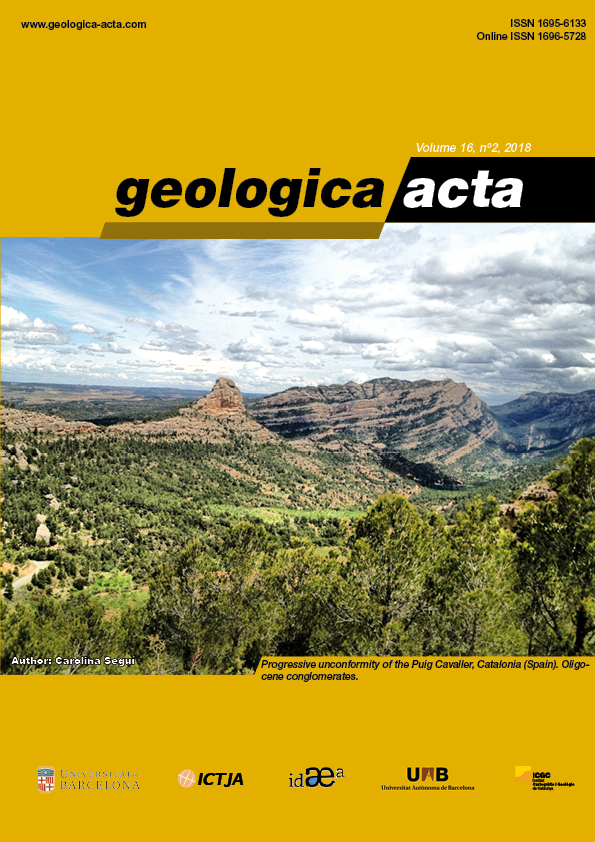The Aragonian type area revisited; comments on paleontology and stratigraphy
DOI:
https://doi.org/10.1344/GeologicaActa2018.16.2.3Keywords:
Miocene, Rodents, Cricetidae, Stratigraphy, PaleomagnetismAbstract
In a recent study of van der Meulen and coauthors, the fossil rodents Fahlbuschia, Pseudofahlbuschia and Renzimys from the Aragonian type area (Calatayud Basin, Spain) were synonimized with Democricetodon. On the basis of the relative chronology provided by Daams and coauthors in an earlier study, these authors construed two evolutionary lineages, distinguished by size. One of these lineages contains Fahlbuschia koenigswaldi (Freudenthal, 1963) and the other one Democricetodon moralesi van der Meulen et al. (2004) but, in view of their great similarity, we consider D. moralesi to be a synonym of F. koenigswaldi.
The relative stratigraphic position of some fossil mammal localities is difficult to establish in the Aragonian type area because it is affected by folds and faults. Early studies of Daams and Freudenthal subdivided the local zone D into D1, D2, D3 and gave a scheme of the stratigraphy in which the fossiliferous locality Valdemoros 1A is considered to be older than Valdemoros 3B. But Daams and coauthors came to the opposite interpretation in a later study, and divided zone D in Da, Db, Dc, Dd. But, new field data presented here enforce the original interpretation in which Valdemoros 1A is older than Valdemoros 3B. This leads to the conclusion that the division of local zone D into Da to Dd has to be discarded, and substituted by the formerly proposed zonation D1-D3.
References
Daams, R., Freudenthal, M., 1981. Aragonian: the Stage concept versus Neogene Mammal Zones. Scripta Geologica, 62, 1-17.
Daams, R., Freudenthal, M., 1988. Synopsis of the Dutch-Spanish collaboration program in the Aragonian type area, 1975-1986. In: Freudenthal, M. (ed.). Biostratigraphy and paleoecology of the Neogene micromammalian faunas from the CalatayudTeruel Basin (Spain). Scripta Geologica, Special Issue, 1, 3-18.
Daams, R., Freudenthal, M., van de Weerd, A., 1977. Aragonian, a new stage for continental deposits of Miocene age. Newsletters on Stratigraphy, 6, 1, 42-55.
Daams, R., van der Meulen, A.J., Álvarez-Sierra, M.A., PeláezCampomanes, P., Calvo, J.P., Alonso Zarza, A.M., Krijgsman, W., 1999a. Stratigraphy and sedimentology of the Aragonian (Early to Middle Miocene) in its type area (North-Central Spain). Newsletters on Stratigraphy, 37, 103-139.
Daams, R., van der Meulen, A.J., Álvarez-Sierra, M.A., Peláez-Campomanes, P., Krijgsman, W., 1999b. Aragonian stratigraphy reconsidered, and a re-evaluation of the middle Miocene mammal biochronology in Europe. Earth and Planetary Science Letters, 165, 287-294.
de Bruijn, H., 1965. Miocene Gliridae, Sciuridae and Eomyidae (Rodentia, Mammalia from the Calatayud area, Zaragoza province (Spain) and their bearing on the biostratigraphy of the area. Ph.D. Thesis, University of Utrecht, 187pp.
de Bruijn, H., 1967. Gliridae, Sciuridae y Eomyidae (Rodentia, Mammalia) miocenos de Calatayud (provincia de Zaragoza,
España) y su relación con la bioestratigrafía del área. Boletín del Instituto Geológico y Minero de España, 78, 187-373.
Fahlbusch, V., 1964. Die Cricetiden (Mammalia) der Oberen Süsswassermolasse Bayerns. Abhandlungen Bayerische Akademie Wissenschaften, 118, 1-136.
Freudenthal, M., 1963. Entwicklungsstufen der miozänen Cricetodontinae (Mammalia, Rodentia) Mittelspaniens und ihre stratigrafische Bedeutung. Beaufortia, 10, 51-157.
Freudenthal, M., 2004. Gliridae (Rodentia, Mammalia) from the Eocene and Oligocene of the Sierra Palomera (Teruel, Spain). Treballs del Museu de Geologia de Barcelona, 12, 97-173.
Freudenthal, M., 2006. The status of Democricetodon, Fahlbuschia, Pseuodofahlbuschia and Renzimys (Cricetidae, Mammalia). A reply to Van der Meulen et al. (2004). Geobios, 39, 43-55.
Freudenthal, M., Cuenca Bescós, G., 1984. Size variation of fossil rodent populations. Scripta Geologica, 76, 1-28.
Freudenthal, M., Daams, R., 1988. Cricetidae (Rodentia) from the type-Aragonian; the genera Democricetodon, Fahlbuschia, Pseuodofahlbuschia nov. gen., and Renzimys. In: Freudenthal, M. (ed.). Biostratigraphy and paleoecology of the Neogene micromammalian faunas from the Calatayud-Teruel Basin (Spain). Scripta Geologica, Special Issue, 1, 133-252.
Gradstein, F., Ogg, J., Smith, A., 2004. A Geologic Time Scale 2004. Cambridge University Press., 610pp.
Krijgsman, W., Langereis, C.G., Daams, R., van der Meulen, A.J., 1994. Magnetostratigraphic dating of the middle Miocene
climate change in the continental deposits of the Aragonian type area in the Calatayud-Teruel Basin (Central Spain). Earth and Planetary Science Letters, 128, 513-526.
Krijgsman, W., Garcès, M., Langereis, C.G., Daams, R., van Dam, J., van der Meulen, A.J., Agustí, J., Cabrera, L., 1996. A new chronology for the middle to late Miocene continental record in Spain. Earth and Planetary Science Letters, 142, 367-380.
van der Meulen, A.J., Peláez-Campomanes, P., Daams, R., 2004. Revision of medium-sized Cricetidae from the Miocene of
the Daroca-Villafeliche area in the Calatayud-Teruel basin (Zaragoza, Spain). Coloquios de Paleontología, Volumen Extraordinario, 1, 385-441.
van der Meulen, A.J., García-Paredes, I., Álvarez-Sierra, M.A., van den Hoek Ostende, L.W., Hordijk, K., Oliver, A., PeláezCampomanes, P., 2012. Updated Aragonian biostratigraphy: Small Mammal distribution and its implications for the Miocene European Chronology. Geologica Acta, 10(2), 159-179.
Downloads
Published
Issue
Section
License
Copyright (c) 2018 Geologica Acta

This work is licensed under a Creative Commons Attribution-ShareAlike 4.0 International License.
Copyright
Geologica Acta is the property of the UB, GEO3BCN, IDAEA and UAB. Geologica Acta must be cited for any partial or full reproduction. Papers are distributed under the Attribution-Share Alike Creative Commons License. This license allows anyone to reproduce and disseminate the content of the journal and even make derivative works crediting authorship and provenance and distributing possible derivative works under the same or an equivalent license.
Author Rights
Authors retain the copyright on their papers and are authorized to post them on their own web pages or institutional repositories. The copyright was retained by the journal from the year 2003 until 2009. In all cases, the complete citation and a link to the Digital Object Identifier (DOI) of the article must be included.
The authors can use excerpts or reproduce illustrations of their papers in other works without prior permission from Geologica Acta provided the source of the paper including the complete citation is fully acknowledged.




